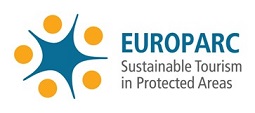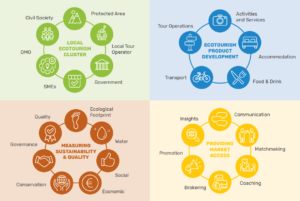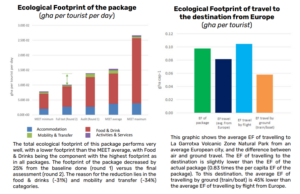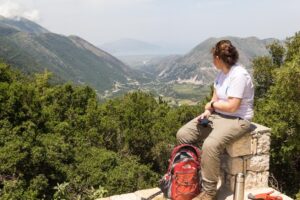Measuring the Environmental Impact of EcoTourism: Learnings and Tools for a Greener Future
Sustainable Tourism is an ever relevant topic for EUROPARC and Protected Areas. Accurately assessing environment impacts is essential if we want truly sustainable tourism. In this article, discover tools developed by the MEET Network that support this process.
Today is World Tourism Day. It is a good day to celebrate that Protected Areas are among the most visited places in Europe.
 The European Charter for Sustainable Tourism (ECST) in Protected Areas is one of EUROPARC main programmes that helps Protected Areas to plan and manage tourism sustainably.
The European Charter for Sustainable Tourism (ECST) in Protected Areas is one of EUROPARC main programmes that helps Protected Areas to plan and manage tourism sustainably.
It has three phases. Phase 1 is addressed to Protected Areas. Phase 2 is addressed to Tourism Business and Phase 3 to Travel Agencies and Tour Operators.
Measuring environmental impact is essential to understand and address any potential damage to the environment. It is one of the key topics that Protected Areas need to work on to obtain their ECST award.
However, accurately measuring environmental impacts and ecological footprint is not easy. The MEET Network provides a new tool to measure environmental impact of ecotourism that could be very useful for ECST Protected Areas, Business and Travel Agencies.
This tool has been already tested in two ECST Parks: Garrotxa Natural Park and Colline Metallifere National Park
Keep on reading to learn more. Plus, mark your calendars for our next webinar on this topic: 2 November 10:00 CET.
This article is written by Arnau Teixidor Costa, Ecosystem Resilience & Spatial Planning Programme and Lucía Prieto Fustes Ecosystem Programme Assistant. Arnau and Lucía both work at IUCN Centre for Mediterranean Cooperation
Measuring the Environmental Impact of EcoTourism: Learnings and Tools for a Greener Future
Ecotourism holds the promise of delivering positive benefits to the conservation of protected areas and local communities by supporting the sustainable development of destinations. However, measuring and evidencing these benefits is challenging. As a result, the different impacts of (eco)tourism are not consistently measured. To address this, the MEET Network and the DestiMED PLUS project partnership have developed a comprehensive approach. This includes a standard, indicators and tools, to assess the enabling conditions for ecotourism to be developed in the protected area destination, and the sustainability and quality of the ecotourism itineraries.

Ecotourists hiking in Kornati National Park © MEET Network (Author: Vicki Brown)
The MEET Network gathers tourism and environmental organizations along protected areas to transform the Mediterranean into a leading ecotourism destination.
MEET was born out of several Euro-Mediterranean initiatives, such as ENI CBC MED Programme MEET project, and its Secretariat is based at the International Union for the Conservation of Nature (IUCN) Centre for Mediterranean Cooperation. Its primary mission is to craft top-tier ecotourism experiences that benefit both environmental conservation and local communities. In the recent DestiMED PLUS project, MEET has perfected its model and its tools for measuring ecotourism impacts.

The 4-step MEET Model. The bottom-left step indicates the approach to measuring the impact of the tourism experiences © MEET Network. Click to enlarge
The MEET model is based on a 4-step process (see the image to the right) which ensures that the itinerary created complies with the promise of ecotourism.
Understanding the impact on Earth’s resources
In the context of global change, a main feature of the MEET approach for measuring impact is understanding the environmental footprint of ecotourism itineraries. This builds on work by the Global Footprint Network in developing a robust methodology for measuring the ecological footprint of ecotourism itineraries, tested by measuring 13 ecotourism itineraries across the Mediterranean. The DestiMED PLUS project allowed not just to refine the understanding of the ecological footprint of 9 new ecotourism itineraries, but also to compare it with the footprint of travel to the destination and the average footprint of travellers and residents. Additionally, it allowed to explore the carbon and water footprints in some destinations, while exploring the capacity of the different environmental foot print methodologies to measure the impact of the tourism sector.
Over the past years, we have been developing, through the MEET Network and its various projects, a participatory process based on data and monitoring processes to develop a sustainable alternative for tourism activities in and around Mediterranean protected areas, which work for the benefit of both people/communities and the planet. Looking forward to the possibility of bringing this approach to other protected areas in the region.
Says Alessandro Galli, President of the MEET Network.

Ecological footprint results in La Garrotxa Volcanic Zone Natural Park © MEET Network. Click to enlarge.
The assessment of the ecological footprint has allowed to draw interesting lessons for ecotourism operators, destination and protected area managers:
- Food & Drinks represented the major footprint driver in all itineraries analysed, contributing on average to 63% of the total.
- On average, the Ecological Footprint of a tourist travelling from Europe to a norther-Mediterranean ecotourism destination is 43% higher than the per capita Ecological Footprint of the average entire stay at destination.
- It is challenging to establish an ideal or maximum ecological footprint per ecotourist per day, as this needs to be assessed along social, cultural and economic impacts in the destination, as well as origin, length of stay, means of travel, etc.
What MEET measuring and monitoring tools can you use?
For protected and conserved area managers to be able to assess and manage different impacts and ensure the enabling conditions for ecotourism to flourish under the MEET Standard, a set of tools has been developed and compiled in an online ecotourism indicator monitoring platform. The platform offers a summary assessment of the environmental and social results for each destination and itinerary, allowing managers to make informed decisions. It also proposes resources and guidelines to streamline the required data collection and analysis. The platform comprises four main tools:
- The Ecological Footprint Calculator: As seen above, it measures tourism services in a package/itinerary across four key categories: accommodation, food & drinks, mobility, and activities & services. It assists tourism stakeholders in analyzing the environmental impact of ecotourism experiences within protected areas. Users gather data through surveys conducted in collaboration with local service providers. The tool harmonizes this data with existing statistics to yield a quantitative ecological footprint and generic recommendations to enhance the sustainability of ecotourism.
- The Social Impact Assessment of Ecotourism Suppliers tool quantifies the social impact generated by diverse ecotourism service providers, suppliers, and facilities included in an itinerary. More importantly, it examines the perspectives of four key stakeholder groups: workers, local communities, value chains, and visitors. This assessment can be understood as an evaluation of the different socio-economic dimensions linked to the ecotourism product and offers a deeper understanding of its social implications.
- In contrast to the preceding tools, which examine the social and environmental impacts of tourism products, the Enabling Conditions Assessment of the Destination introduces a set of criteria that destinations are encouraged to embrace to establish the necessary foundations for sustainable tourism practices. They aim to safeguard natural resources, bolster local communities, and advocate for responsible ecotourism development. The tool is based on IUCN’s Best Practice Guidelines for the Governance of Protected Areas to establish an evaluation framework, incorporating a simplified version of the IUCN Green List Global Standard for Protected Areas.
- In a similar fashion, the Product Quality Assessment of an Ecotourism Itinerary tool delves into crucial aspects related to product and itinerary design, safety protocols, supplier selection, and more. This assessment is conducted through a survey process that harnesses existing data already available to the Inbound Tour Operator.
Looking ahead

Ecotourist in Vlorë, Albania © MEET Network (Author: Vicki Brown)
There are many challenges and opportunities for ecotourism to deliver its promise as it navigates the delicate balance between economic development and environmental conservation. In a context of overvisitation in many protected and conserved areas, supporting a tourism officer that is delivering positive impacts is needed. For this, a comprehensive approach for measuring the impacts of ecotourism is essential, championing ecotourism as an important piece upon which the tourism sector changes in the face of the climate and biodiversity crisis and the call for regenerative and responsible tourism. And this message cannot stay in the Protected Areas, it needs to reach destination managers and marketers , industry and travellers.
Interested in learning more? Have a look at the MEET website and manual!